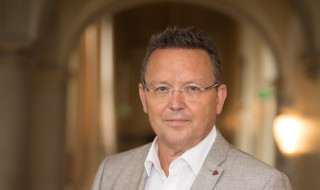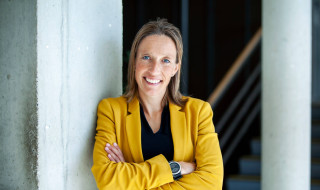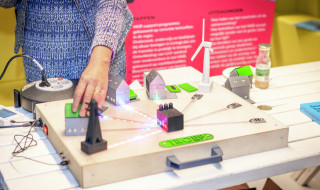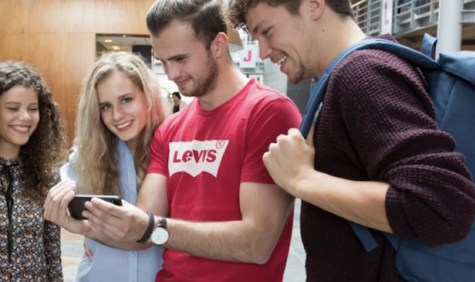Collaborative research is pivotal in achieving transitions
Cooperation between universities, universities of applied sciences, and the MBO is crucial to tackle the major societal challenges. It is therefore important that researchers know who at other institutions is working on what research. The new platform Publinova makes the research of universities of applied sciences accessible and visible to everyone.
The platform was developed together with universities of applied sciences and now that it is in place, researchers can more easily cooperate or build on previous research outside their own institution. This is the only way to jointly tackle major challenges such as the consequences of an ageing population or climate change.
What is the importance of practice-based research for the major transitions, and how does Publinova contribute to cooperation between sectors? We asked Jouke de Vries, chair of the Board of Governors of the University of Groningen (RUG), Saskia te Velde, programme manager at the Knowledge Centre Healthy & Sustainable Living and senior researcher at the Research Group Innovation of Occupational Health Care at Utrecht University of Applied Sciences (HU), and Jorick Scheerens, programme director of Stichting Practoraten.nl.
About Publinova
The platform allows universities of applied sciences to connect with the world and increase the impact of practice-based research. It provides space for presenting information about researchers, research projects and results, but you can also search for other research, publications, people involved or institutions.

Jouke de Vries, University of Groningen
Interaction between sectors
Tackling major transitions, such as the Sustainable Development Goals, requires a combination of fundamental and practice-oriented research, says Jouke de Vries. "Universities and universities of applied sciences each have their own role. Universities are known for their curiosity-driven and scientific research. University of applied sciences research tends to be more application-oriented. Although the distinction is less sharp these days and there is always a great interaction. The difference is mainly that universities of applied sciences are much more concerned in their research with the tools to arrive at solutions."
"There is always a great interaction between research from universities of applied sciences and universities."
"The interesting thing is that the research of universities of applied sciences and universities is coming together more and more, and the MBO is also joining in," De Vries continues. "For all major transitions, you need all three of those types of institutions. We therefore see that cooperation is increasing. The solar race car is a great example. It is made by wo, hbo and mbo students."

Hybrid departments
The RUG already works extensively with universities of applied sciences and MBO. De Vries gives some examples. "On the Greenwise Campus, we work together with the university of applied sciences NHL Stenden, Drenthe College, the province of Drenthe and the municipality of Emmen. For example, on renewable plastics to tackle pollution. And with the Hanze we have hybrid departments in the field of energy transition with professors, lecturers and sometimes a practor from the MBO. The RUG does fundamental research on hydrogen. The universities of applied sciences investigate how we get hydrogen to homes and companies, and then you need MBO technicians for that."
A platform like Publinova promotes this kind of cooperation, says De Vries. "Via Publinova, researchers from universities, colleges and mbo can find each other more easily. This is important, because we don't want a merger - that takes too much energy, but on themes we can cooperate very well. And if the research is published on Publinova open access, researchers, companies and citizens can take note of it and build on it."
All universities of applied sciences will be buyers of Publinova by 1 July 2024 and can be connected. With this development, it is expected that in the coming time, more results of applied research from universities of applied sciences will become available on Publinova. Eventually, this will give the entire higher education sector a place on this platform.

Saskia te Velde, Utrecht University of applied sciences
Research with and for practice
HU researcher Saskia te Velde also says research collaboration between wo, hbo and mbo is essential for achieving transitions. "The three types of research complement and overlap. An important feature of practice-based research by universities of applied sciences is that it is always conducted with and for practice. This requires a different methodology that takes into account non-controlled environments and we have a connecting role between research, education and practice."
"For showcasing products, apps, toolkits and prototypes as results of practice-based research, Publinova is essential."
Apart from being a researcher, Saskia is also programme manager at HU's Research Centre for Healthy and Sustainable Living and sees that collaboration between sectors is increasingly a prerequisite for grant applications. "It is therefore important that we know what we are doing about each other. Publinova can help with this."
Products, apps, prototypes
Practice-oriented research produces not only articles but also other research results, Saskia outlines. "Think of manuals, apps, products, prototypes and technologies, such as sensors. We can publish articles on platforms like Research Gate, but for showcasing products, apps, toolkits and prototypes, Publinova is essential. At a meeting of Regieorgaan SIA recently, I heard that technical universities are also interested in publishing these kinds of research results on Publinova. Because in platforms like the aforementioned Research Gate, these products cannot be included."

University of applied sciences research results from project Trump for children with disabilities. Photo: Femke van den Heuvel.
Saskia thinks it is important that the research results of universities of applied sciences, but also of other institutions funded with public money, are published open access. "Everyone should be able to benefit from what we develop with public money. Open science also contributes to the transparency and quality of research. For example, you can share your research design before you start your research."
Possible partners
It is important that research projects and results are visible to potential research partners, says Saskia. "Our knowledge centre wants to cooperate with municipalities, GGDs, professional and welfare organisations, and companies developing new technology. On Publinova, we can show what we are doing."
But Publinova will only work well if more universities of applied sciences participate, Saskia believes. That is what is being worked hard on now. "Publinova must be well populated and links with the research registration systems of the universities of applied sciences must work better. The basic principle is that what researchers put in the registration system automatically enters Publinova. Unfortunately, that link does not always work well yet."
"Furthermore, Publinova should be better known in the outside world. For example, through a campaign." Board members of universities of applied sciences have now committed to Publinova. Now is the time to ensure that first those things are taken care of, which are necessary for Publinova to work well. "We can only campaign when the links are working properly and Publinova is well stocked," he says.
"For practitioners, it is very useful that we can see on Publinova who is working on what."

Jorick Scheerens, Praktoraten.nl Foundation
Connecting to existing knowledge
Publinova is very valuable for practorates, says Jorick Scheerens, director of Practoraten.nl. "Practorates carry out practice-oriented research to better align secondary vocational education with professional practice. Because of the social issues that are urgent now, professional practice is changing and the MBO curriculum needs to be adapted. Practorates provide insight into the state of knowledge on specific themes. We always look first at what knowledge is already there. So it is very useful that we can see on Publinova who is working on what."
If research results are published on Publinova open access, that is very nice, Jorick stresses. "Because as mbo's are not recognised knowledge institutions, we don't have access to non-open access published research." Jorick hopes that the research of practorates can also appear on Publinova. "Now only researchers and lecturers from universities of applied sciences can publish on Publinova. We obviously ensure high-quality research!"
Text: Anneke de Maat

